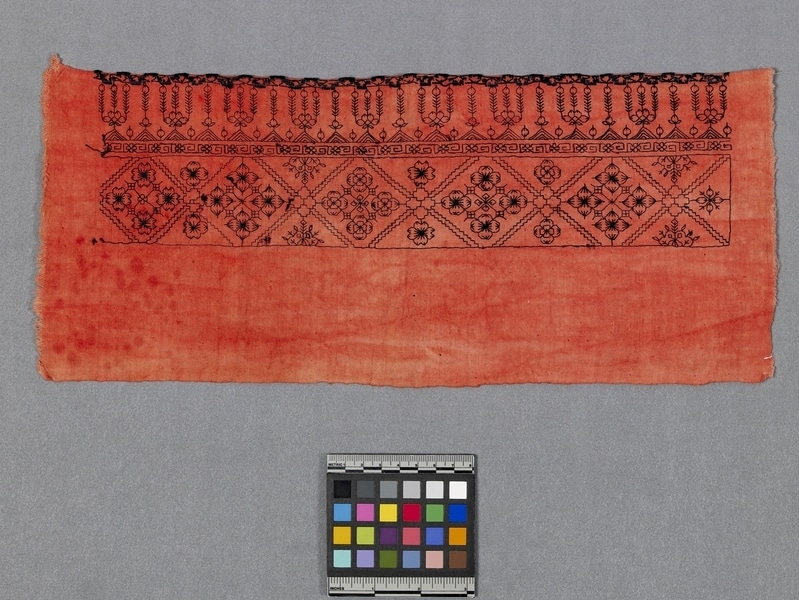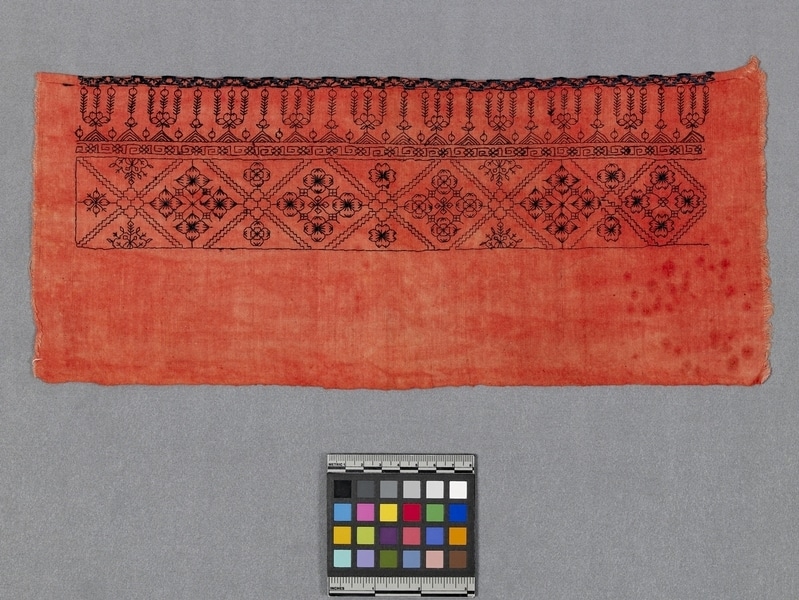Textile Item Number: Edz1336 from the MOA: University of British Columbia


Description
Rectangular, brocade textile of red fabric with black detailing. Selvage on one side and hemmed on the other in joo-i design; the ends are raw. Three patterned bands run along the hem. The first band consists of a stylized pondweed, lotus and waves. The second band has a key and floral pattern, while the third band is wider than others and has a diaper pattern with flowered diamonds.
History Of Use
Blue and white embroideries are part of an ancient domestic tradition. Patterns consisted of varied arrangements of classical and folkloric symbols. Square linen or cotton pieces were woven on wooden looms 30.5 to 63.5 cm. wide. Designs vary geographically but are constant within generations of families except for minor individual variations. Finished articles are often given to, or made by a bride; used as samplers, children's clothing, and as household linens especially for the decoration of the exposed edges of bed sheets or bed canopies. The bed traditionally played a focal part in household ritual, particularly at the new year when all household spirits were honored. They were family made, by women, and family owned.
Cultural Context
utilitarian; household
Narrative
Blue on white embroidered textiles were traditionally made until the end of the 19th century by rural and village women of the western provinces, especially in rich agricultural communities of Szechwan, Shensi, and Yunnan. These were collected in the 1930's. The collector was impressed by the quality of the workmanship. These embroideries were of no local commercial value at the time, as the owners preferred machine manufactured goods.
Iconographic Meaning
Taoist mystic symbols of creativity derived from yin and yang symbols (joo-i and key patterns). Pondweed and wave are symbols of water spirits.
Item History
- Made in Chengdu, Sichuan, China before 1945
- Collected between 1932 and 1945
- Owned by Kathleen F. Spooner before April 25, 1979
- Received from Kathleen F. Spooner (Seller) and Museum of Anthropology Donations Fund (Funding source) on April 25, 1979
What
- Name
- Textile
- Identification Number
- Edz1336
- Type of Item
- textile
- Material
- dye and cotton fibre
- Manufacturing Technique
- woven, dyed, stitched and embroidered
- Overall
- height 40.6 cm, width 17.4 cm
Who
- Culture
- Chinese
- Previous Owner
- Kathleen F. Spooner
- Received from
- Kathleen F. Spooner (Seller) and Museum of Anthropology Donations Fund (Funding source)
Where
- Holding Institution
- MOA: University of British Columbia
- Made in
- Chengdu, Sichuan, China
When
- Creation Date
- before 1945
- Collection Date
- between 1932 and 1945
- Ownership Date
- before April 25, 1979
- Acquisition Date
- on April 25, 1979
Other
- Item Classes
- textiles
- Condition
- good
- Accession Number
- 0567/0111